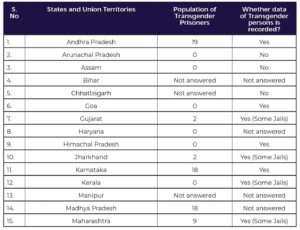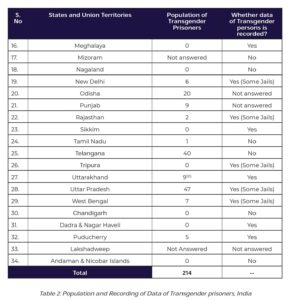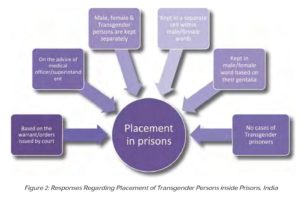On 27th November 2020, the Commonwealth Human Rights Initiative (CHRI) published ‘Lost Identity: Transgender Persons in Indian Prisons’. The report analyses the rights and treatment of the LGBTI+ community, confined in Indian prisons, especially transgender prisoners. It highlights the issues faced by transgender prisoners and provides pertinent information on compliance within prisons. The report is based upon the responses received by CHRI against their Right to Information (RTI) applications. These had been filed to the Prison Head Quarters (PHQ) of all the States and Union Territories except Jammu and Kashmir. Here’s a summary of what the report has uncovered:
- Does gender data in prison documentation recognise the ‘third gender’? The answer to this question proved disappointing. The responses from various State prisons provided that data collection was non-uniform. The report states, “Out of the 28 states and six union territories that responded to this particular question, only nine of them (Andhra Pradesh, Goa, Himachal Pradesh, Karnataka, Meghalaya, Sikkim, Uttarakhand, Dadra & Nagar Haveli and Puducherry) stated that the data of Transgender inmates was being recorded apart from male and female. Nine of them (Arunachal Pradesh, Assam, Chhattisgarh, Mizoram, Nagaland, Tamil Nadu, Telangana, Chandigarh, and Andaman & Nicobar Islands) stated that the data of Transgender inmates was not being recorded separately.” In some states like Jharkhand, Uttar Pradesh, New Delhi, West Bengal etc., there is an internal non-uniformity in jail record-keeping.

- How many transgender persons are there in Indian jails? According to the data received by CHRI, between May 2018 and April 2019, a total of 214 transgender persons are recorded to be imprisoned in different prisons throughout the country. However, the authors point out that in absence of a uniform system of gender documentation, the aforementioned number is likely to be a skewed representation of the transgender community in prisons.

- What is the placement of transgender persons in prison? The report states that in absence of a uniform system of handling transgender prisoners, they are mostly placed on basis of their biological makeup or upon the advice of the medical officer. However, in some states like Andhra Pradesh, Gujarat, Maharashtra, Kerala and others, transgender prisoners are kept separately from male or female inmates. They are either kept in separate cells, isolation wards or inside hospitals.

- Do transgender persons get recruited as prison administration? According to the RTI responses, no transgender persons were recruited by the prison department in any of the States or Union Territories between 1st January 2014 to 1st January 2019.
- How aware are the prisoners and the prison administrations regarding the legal recognition of the third gender and their rights? It has been found that the no awareness campaign has been undertaken by the government to educate the prisoners about the legal recognition of the third gender. The administration too doesn’t receive any special training which could sensitise them on the topic.
In conclusion, the authors suggest a number of recommendations to improve the present situation, including better prison processing, increased documentation, spreading awareness and creation of better training programs for the prison administration. They say that the, “…recommendations of the report have been finalised through a consultative process with individuals and experts, including representatives from the community, community-based organisations as well as researchers and academicians working on this issue.”
Read the complete report here.



